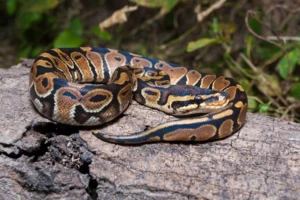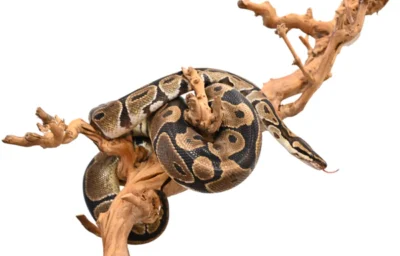Curled comfortably in their terrariums, ball pythons, with their enigmatic gaze and serpentine grace, captivate reptile enthusiasts worldwide. Yet, for those venturing into snake ownership, questions often arise regarding their dietary needs. Central among these inquiries is the frequency of feeding: How often do ball pythons eat?
Ball pythons are typically fed every 5 to 7 days when they are hatchlings or juveniles. As they grow older, their feeding frequency decreases to about every 7 to 14 days. However, individual needs may vary based on factors such as age, size, metabolism, and overall health.
It’s essential to monitor your ball python’s body condition and adjust its feeding schedule accordingly. Additionally, fasting periods, especially during breeding season or times of environmental changes, are normal for ball pythons and shouldn’t cause concern as long as the snake remains healthy and maintains a proper body weight.
Importance of understanding ball pythons feeding habits

Understanding the feeding habits of ball pythons is crucial for their overall health and well-being in captivity. Here’s why it’s important:
- Nutritional Needs: Ball pythons, like all animals, require specific nutrients to thrive. Understanding their feeding habits helps ensure they receive a balanced diet that meets their nutritional requirements. Feeding them appropriately sized prey items at the right frequency ensures they get the necessary vitamins, minerals, and proteins.
- Health Monitoring: Monitoring a ball python’s feeding habits can provide valuable insights into its health. Changes in appetite or feeding behavior could indicate underlying health issues such as illness, stress, or improper husbandry. Regular feeding patterns and appetite levels can serve as indicators of overall well-being.
- Preventing Obesity: Overfeeding is a common issue in captive ball pythons, leading to obesity and related health problems. Understanding their feeding habits helps prevent overfeeding by offering appropriately sized meals at appropriate intervals. This promotes a healthy weight and reduces the risk of obesity-related issues such as fatty liver disease.
- Preventing Underfeeding: Conversely, underfeeding can also be detrimental to a ball python’s health. Understanding their feeding habits helps ensure they receive an adequate amount of food to support their growth and metabolism. Consistently monitoring their appetite and adjusting feeding schedules as needed prevents underfeeding and its associated complications.
- Behavioral Enrichment: Feeding time is not just about providing sustenance; it also offers mental stimulation and enrichment for ball pythons. Understanding their feeding habits allows keepers to tailor feeding methods to encourage natural hunting behaviors, such as using different prey items or feeding techniques. This helps maintain their mental and physical well-being in captivity.
Factors Affecting ball Pythons Feeding Frequency
Frequency of feeding ball pythons based on age groups
Feeding frequency for ball pythons can vary based on their age groups. Here’s a general guideline:
- Hatchlings (0-6 months): Hatchlings are typically voracious eaters and have rapid growth rates. They usually feed on appropriately sized prey every 5 to 7 days. Offer them small-sized rodents or appropriately sized feeder insects.
- Juveniles (6 months – 1 year): Juvenile ball pythons continue to grow quickly during this stage but may start to decrease their feeding frequency slightly. Feed them every 7 to 10 days, adjusting the size of prey according to their growth.
- Subadults (1-3 years): Subadult ball pythons are still growing but at a slower rate compared to hatchlings and juveniles. They can be fed every 10 to 14 days, depending on their individual metabolism and size.
- Adults (3 years and older): Adult ball pythons have reached their full size and growth rate has significantly slowed down. They typically require feeding every 10 to 14 days or even every 2 to 3 weeks for larger individuals. It’s important to monitor their body condition and adjust feeding frequency accordingly to maintain a healthy weight.
Keep in mind that these are general guidelines, and individual snakes may have different requirements based on their metabolism, activity level, and overall health. Always monitor your ball python’s body condition and adjust the feeding schedule as needed to ensure they maintain a healthy weight.
Additionally, some ball pythons may fast for periods of time, especially during breeding season or when they are stressed, which is normal behavior.
Feeding Schedule for Ball Pythons

Establishing a feeding schedule for your ball python is crucial for its health and well-being. Here’s a recommended feeding schedule based on age:
- Hatchlings (0-6 months): Feed hatchlings once every 5 to 7 days. Offer appropriately sized prey items, such as fuzzy mice or rat pinkies. Make sure the prey item is no wider than the thickest part of the snake’s body.
- Juveniles (6 months – 1 year): Feed juveniles once every 7 to 10 days. Increase the size of the prey items as the snake grows. Small mice or rat pups are suitable for this age group.
- Subadults (1-3 years): Feed subadults once every 10 to 14 days. At this stage, the snake’s growth rate slows down, so they require less frequent feedings. Adult mice or small rats can be offered as prey items.
- Adults (3 years and older): Feed adult ball pythons once every 10 to 14 days or even every 2 to 3 weeks for larger individuals. The frequency of feedings can vary based on the snake’s size, metabolism, and activity level. Offer appropriately sized rats or mice as prey items.
When feeding your ball python, it’s essential to monitor its body condition. You want to ensure that the snake maintains a healthy weight without becoming underweight or overweight. Adjust the feeding schedule as needed based on your snake’s individual requirements and any changes in its appetite or activity level. Additionally, always provide fresh water in a shallow dish for your ball python to drink from.
Signs of underfeeding and overfeeding
Recognizing signs of underfeeding and overfeeding in ball pythons is crucial for maintaining their health and well-being. Here are some indicators to watch for:
Signs of Underfeeding:
- Visible Ribs and Spine: If your ball python’s ribs and spine are prominently visible or easily felt, it may be a sign that the snake is underfed and lacking sufficient body fat.
- Reduced Body Mass: A ball python that appears thin and has a reduced body mass compared to its length may not be receiving enough food.
- Lethargy: Underfed ball pythons may display decreased activity levels and appear lethargic or weak.
- Poor Shedding: Inadequate nutrition can lead to poor shedding, resulting in retained eye caps or pieces of shed skin stuck to the snake’s body.
- Frequent Begging for Food: If your ball python is constantly seeking food or actively searching its enclosure for prey, it may not be getting enough to eat.
Signs of Overfeeding:
- Obesity: Overfed ball pythons may become overweight, with visibly bulging sides and a rounder appearance. They may also have difficulty moving or appear sluggish.
- Difficulty Shedding: Excessive fat deposits can impede the shedding process, leading to retained shed or incomplete sheds.
- Regurgitation: Overfeeding can cause regurgitation, where the snake vomits undigested food. This can be harmful to the snake’s digestive system and may indicate that it’s being fed too much or too frequently.
- Fatty Liver Disease: Overfeeding can lead to the development of fatty liver disease, a serious condition that affects the liver’s ability to function properly.
- Decreased Activity: While some ball pythons naturally have lower activity levels, overfed snakes may become even more sedentary due to the additional weight they are carrying.
To ensure your ball python is receiving the appropriate amount of food, it’s essential to monitor its body condition regularly and adjust the feeding schedule accordingly. Consult with a veterinarian or experienced reptile keeper if you’re unsure about your snake’s dietary needs or if you notice any concerning signs of underfeeding or overfeeding.
Health factors influencing feeding behavior
Several health factors can influence the feeding behavior of ball pythons. Understanding these factors is essential for ensuring your snake’s health and well-being. Here are some health issues that may affect a ball python’s feeding behavior:
- Respiratory Infections: Respiratory infections can cause difficulty breathing and decreased appetite in ball pythons. If your snake is wheezing, has mucus around the mouth or nostrils, or exhibits open-mouth breathing, it may be suffering from a respiratory infection.
- Parasites: Internal parasites, such as nematodes and protozoa, can affect a snake’s digestive system and appetite. Symptoms may include weight loss, regurgitation, diarrhea, or abnormal feces.
- Mouth Rot (Stomatitis): Mouth rot is a bacterial infection of the mouth and gums that can make it painful for a snake to eat. Signs of mouth rot include swelling, redness, and discharge around the mouth, as well as reluctance to eat.
- Metabolic Bone Disease (MBD): MBD is a condition caused by calcium and vitamin D3 deficiencies, leading to weakened bones and muscle tremors. Snakes with MBD may have difficulty capturing and swallowing prey, resulting in decreased appetite.
- Digestive Issues: Constipation, impaction, or other digestive issues can cause discomfort and reduce a snake’s appetite. Signs of digestive problems may include lethargy, bloating, and abnormal bowel movements.
- Stress: Ball pythons are susceptible to stress, which can result from factors such as improper husbandry, handling, or environmental changes. Stress can lead to decreased appetite or refusal to eat.
- Injuries: Physical injuries, such as cuts, abrasions, or burns, can cause pain and stress, leading to decreased appetite in ball pythons.
- Reproductive Activity: During the breeding season, male ball pythons may lose interest in feeding as they focus on mating behaviors. Similarly, female ball pythons may experience decreased appetite during pregnancy and egg incubation.
- Old Age: As ball pythons age, their metabolism may slow down, leading to decreased appetite. Additionally, older snakes may be more prone to health issues that affect their ability to eat.
If you notice any changes in your ball python’s feeding behavior, it’s essential to investigate the underlying cause and address any potential health issues promptly. Consulting with a veterinarian experienced in reptile care can help diagnose and treat health problems in ball pythons.
Conclusion
How often do ball pythons eat? The frequency of feeding for ball pythons depends on various factors such as age, size, health, metabolism, and environmental conditions. Generally, hatchlings and juveniles require more frequent feedings, ranging from every 5 to 10 days, while subadults and adults can be fed less frequently, typically every 10 to 14 days or even every 2 to 3 weeks for larger individuals.
It’s essential to monitor your ball python’s body condition and adjust the feeding schedule accordingly to ensure they maintain a healthy weight.



